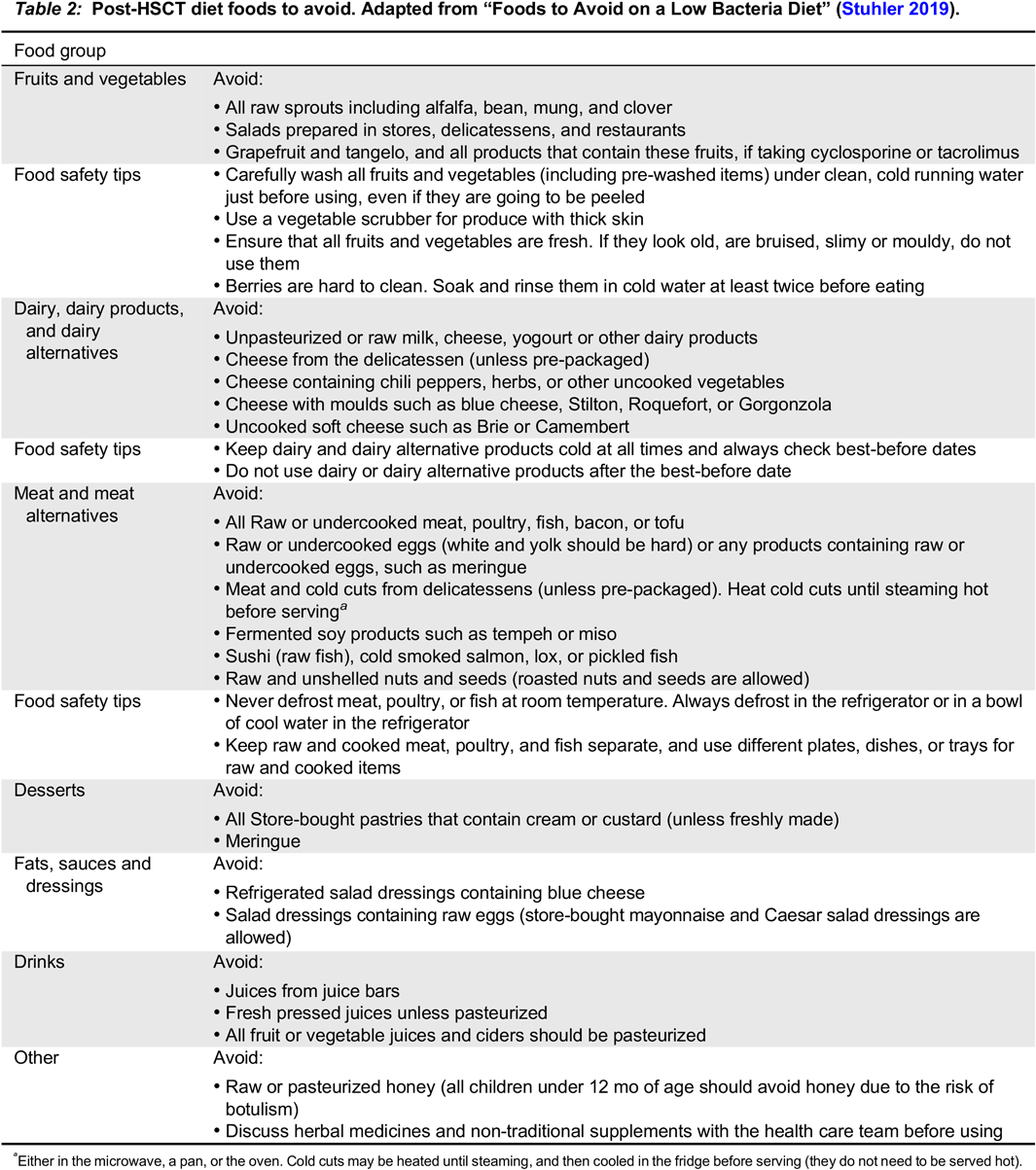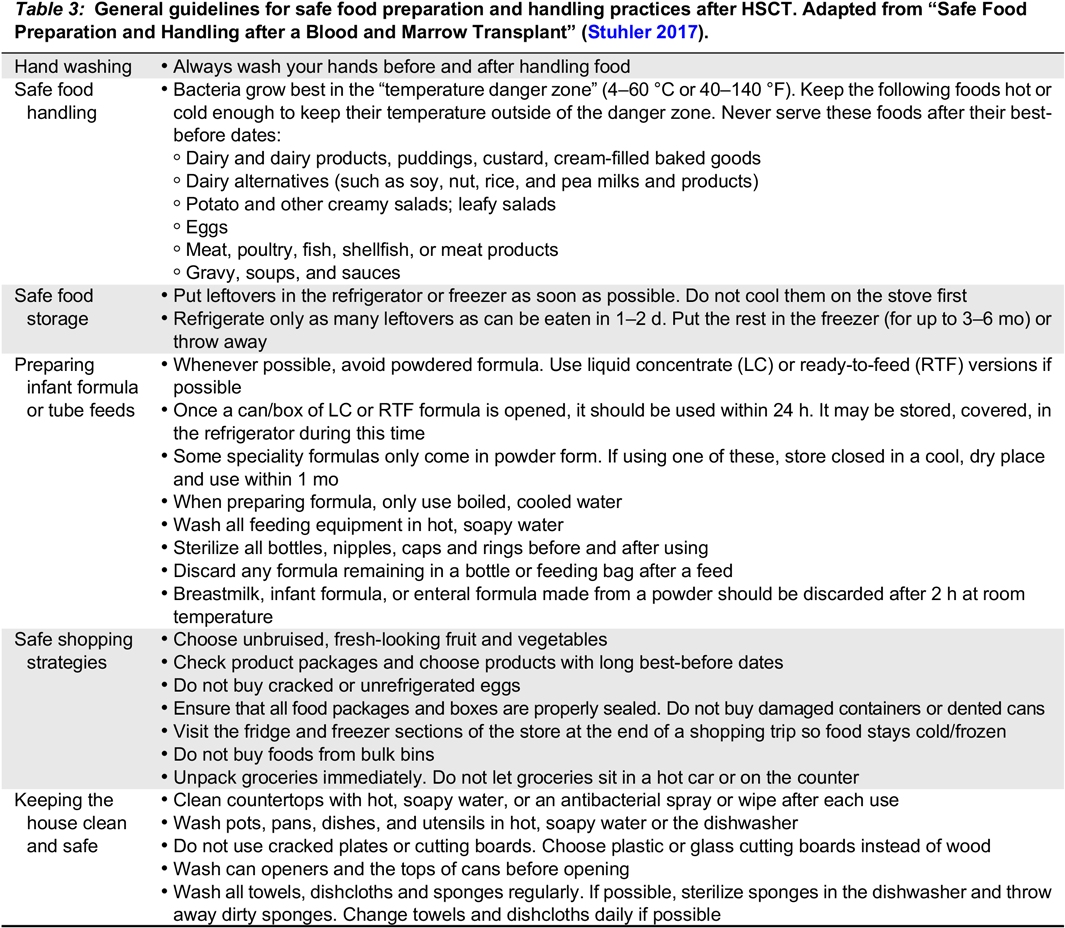With an increasing body of evidence supporting use of a more liberal diet, many North American centres are moving towards a less restricted, food-safety based (FSB) approach, backed further by guidelines from food and health agencies including the CDC, USDA, FDA, and Health Canada (
Tramsen et al. 2016;
Baumgartner et al. 2017a;
Barnett 2019). Most paediatric centres in Canada now follow the FSB approach, which patients and families find far more palatable than the restrictive diets of the past, and as a result, much easier to adhere to (
Neumann et al. 2016;
Tramsen et al. 2016;
Baumgartner et al. 2018;
Barnett 2019). At present, SickKids Hospital in Toronto, Ontario, follows the FSB approach, recommending a significantly liberalized diet compared to past practice (
Stuhler 2017,
2019). Out of familiarity, the diet is still called the “low bacteria diet” (
Table 1,
2) but is entirely food-safety based, and adapted from Health Canada’s diet recommendations for immunocompromised individuals (
Health Canada 2012,
2015). The food-safety approach followed by SickKids and many other centres focuses on safe food handling and preparation (
Table 3), and avoidance of foods that are known to have the potential to cause food-borne illness, including undercooked eggs, meat, poultry, and fish, and unpasteurized dairy products. Fresh fruits and vegetables, heavily restricted in the past, are allowed, enhancing the overall nutritional composition of the diet with the reintroduction of vitamins, minerals, and fibre. Yoghurt and kefir are allowed, as are pickled and some fermented products such as kimchi and sauerkraut. Food from restaurants, if safely prepared, is permitted. Municipal tap water is allowed, and sterile or boiled water not recommended except in the case of untested well water supply or for preparation of infant or therapeutic enteral formulas (
Health Canada 2015;
Stuhler 2017,
2019). Palatability and access to food (particularly for families far from home and without good kitchen facilities) is increased with the FSB approach. There may also be institutional cost-saving advantages to adoption of the FSB diet, as less work, staff, and special products are required at the hospital-level to support the diet (
Moody et al. 2018). Despite this trend, enormous amounts of variability still exists in terms of centre-to-centre practices around diet recommendations. In a survey of 17 Swiss centres performing HSCTs,
Baumgartner et al. (2017b) found no consensus in terms of existence of an HSCT-specific diet, particularly for autologous-HSCT patients (as some centres did not require any type of special diet for this group), recommended length of time a diet should be followed if it was in place, and which foods were allowed while following the diet. While there were similarities noted in terms of food preparation and recommended avoidance of undercooked meat/fish/eggs and unpasteurized dairy, some centres continued to advise against eating raw fruits and vegetables while others allowed it.
Vicenski et al. (2012) describe similar inconsistencies across 17 centres in Brazil, and other studies report the same variation in practice in other parts of the world (
Lipkin et al. 2005;
Fox and Friefeld 2012;
Baumgartner et al. 2017a;
Wolfe et al. 2018;
Barnett 2019;
Moody 2019). A body of literature is emerging showing minimal benefit of the ND/LBD approach in comparison to a FSB diet, which may help standardize approaches in the future.
Current body of evidence
In a 2018 review of the literature,
Baumgartner et al. (2018) found no positive influence on overall rates of infection, incidence of bacteremia or fungemia, or mortality in patients receiving a more restricted diet, and reported that some studies showed an increased risk of infection within the ND/LBD group.
Tramsen et al. (2016) saw no effect on fever, bacteremia, incidence of pneumonia and gastrointestinal infections with use of a restricted diet and state that based on their findings the ND/LBD approach cannot be considered more effective or indeed necessary.
Moody (2019) report no conferred protective effect for those receiving a restricted diet in terms of infection rates, and
Neumann et al. (2016) saw no increases in norovirus or central-line associated bloodstream infections (CLABSI) in the FSB group.
Taggart et al. (2019) completed the first randomized control trial in paediatric HSCT comparing infections (bloodstream and gastrointestinal), incidence of GvHD, and overall survival using a before- and after-study design with a ND/LBD and FSB diet. Looking at the first 100 days post-HSCT, they found no difference in incidence of bloodstream infections, no increased incidence in norovirus infections, no noted increase in incidence of gut-GvHD, or differences in overall survival rates between groups (
Taggart et al. 2019). Based on their findings, they recommend that all centres follow a FSB-approach. This recommendation follows those by Baumgartner, Tramsen, Moody, and other groups who believe in the safety of the FSB method (
Fox and Friefeld 2012;
Trifilio et al. 2012;
Boyle et al. 2014;
Tramsen et al. 2016;
Baumgartner et al. 2018;
Moody et al. 2018;
Wolfe et al. 2018;
Barnett 2019;
Moody 2019).
Although most studies have found no difference in infections between groups following ND/LBD and FSB diets, a few groups have seen increased complications in the ND/LBD groups, including
Baumgartner et al. (2018) as described above, and
Trifilio et al. (2012), who noted increased rates of infections and urinary tract infections in the group receiving a restricted diet.
Baumgartner et al. (2018) also reported higher heart rates in the ND group, which they could not explain. These and other teams hypothesize that many bacteria commonly found on food are a part of the normal gut flora and do not act in a harmful way once colonized in the gut (
Fox and Friefeld 2012;
Trifilio et al. 2012;
Boyle et al. 2014;
Lassiter and Schneider 2015;
Wolfe et al. 2018;
Taggart et al. 2019). Instead, they may confer a protective effect by maintaining the patient’s normal gut flora. Any shifts in nutritional intake (either imposed or natural as a result of HSCT-related side effects) or addition of medications that impact the gut (such as antibiotics) may impact the makeup and function of the gut flora and microbiome, potentially leading to increased risk of infection (
Fox and Friefeld 2012;
Wolfe et al. 2018;
Taggart et al. 2019). This has not yet been proven, but is one of the main arguments for a more liberalized diet given emerging evidence of the importance of the microbiome for HSCT patients (
Wolfe et al. 2018).
Counselling focus
Regardless of the diet a centre chooses to follow, focus should be placed on ensuring that patients receive clear, concise, and practical resources, and if applicable, education. All staff members, regardless of role, should be well versed in the diet, so that information provided to families is consistent. When limited resources make in-person diet teaching challenging, patient education materials must be available that are easy to read, understand, and access. Ideally patient education materials should be available in multiple languages. At present, the guidelines used at SickKids are available online for open use, and can be accessed in English, French, Arabic, and simplified Chinese. Further translation into other languages commonly seen in the SickKids HSCT patient population including Urdu, Bengali, Hindi and Portuguese will hopefully happen in the near future.






